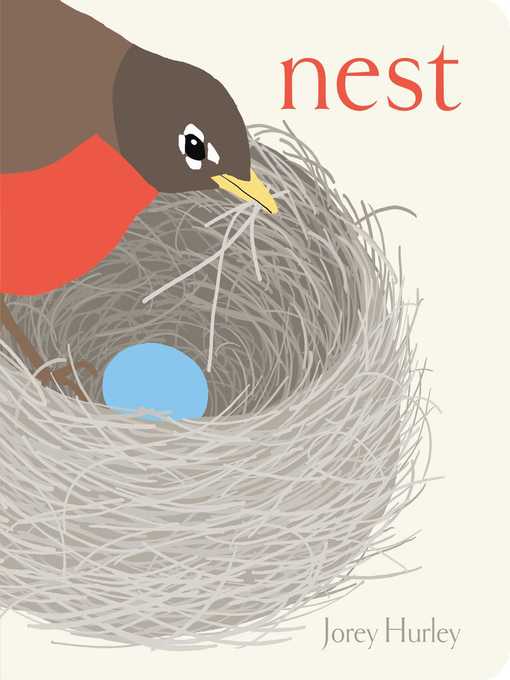
Nest
کتاب های مرتبط
- اطلاعات
- نقد و بررسی
- دیدگاه کاربران
نقد و بررسی

November 18, 2013
Newcomer Hurley lets her bright, clean illustrations do her storytelling, limiting the text on each page to a single, evocative word. The first spread—“nest”—accompanies two robins guarding a precious blue egg. Like silk-screened images, Hurley’s digitally created artwork represents the birds and the trees they live in with flat, sharply delineated areas of color on matte pages; airy white space in the compositions duplicates the freedom in which the birds live and soar. Although the forms are stripped down, some small details are preserved, like the intricately woven twigs of the nest and the sparks of light in the birds’ eyes. “Grow” shows the robins bringing worms to their nestling amid a bower of blossoms; throughout, Hurley celebrates the changing seasons. Although it suggests itself as a bedtime book, the arc of the story is not day moving into night, and the page that says “sleep” is not the last one—with an “Awake,” the next spread shows the rising sun. Robins meet other robins and start again where they began: “Nest.” A handsome, disciplined debut. Ages 3–7. Agent: Laurie Abkemeier, DeFiore and Company.

December 1, 2013
Hurley's penchant for textile design is clearly apparent in this debut picture book. Japanese-style, flat, colored illustrations depict scenes in the life of a family of American robins, from hatching, feeding, learning to fly and social interactions among birds through changing weather and foliage. Even the endpapers are part of the story, showing simple robins' egg shapes. Unfortunately, this style of illustration is inherently static, and its paucity of detail is unlikely to hook children's interest, especially where wildlife is concerned. The too-empty spreads lack real interest or substance, presenting the birds and trees as designer shapes rather than living entities. A single word placed on each spread offers a short gloss on each illustration, but beyond the obvious progress through seasons, the relationships among the words are frequently ambiguous. Readers are more or less left to tell the story on their own, belying the book's apparent simplicity. The author's note describing the life cycle and behavior patterns of the American robin is necessary, as it gives information mostly lacking in the rest of the book. This superficial robin's-eye view of a year does not really get off the ground. (Picture book. 2-5)
COPYRIGHT(2013) Kirkus Reviews, ALL RIGHTS RESERVED.

Starred review from January 1, 2014
PreS-Gr 1-In this stunning debut, we meet a pair of robins and their egg. We watch the parents incubate and hatch the egg and teach the baby bird to survive and fly. Seasons change, colors change. The family faces danger, but ultimately finds safety and comfort. This story is told primarily through the crisp illustrations that have a light, airy quality. The narrative includes only fifteen words, one on each spread, which adds to the dramatic impact: "Nest...warm...hatch....grow...jump...." The conceptual space between each page turn invites readers to thread together the story and imagine each step in the bird's journey. The illustrations evoke the eloquent simplicity of a Japanese woodblock print while the frontispiece depicts clusters of robin's eggs, reminiscent of clouds in a Georgia O'Keefe painting. Every page resonates with a vision that is both ethereal and quotidian. The birds are depicted naturalistically and an author's note includes factual information about robins and their nests. Nest's beauty and originality will stand up to countless re-readings.-Jess deCourcy Hinds, Bard High School Early College, Queens, NY
Copyright 2014 School Library Journal, LLC Used with permission.

daniela909 - I love this book so much you guys should read this it is do touching please you have to read this you have to ^-^

January 1, 2014
Preschool-G Using just one word per double-page spread, this simple story beautifully illustrates the passing of a year in the life of a robin. The first scene illustrates nest, as mother and father bird look proudly down into their nest, comfortably housing a beautiful blue egg. Especially appealing is the page warm, wherein the mother sits on the egg, the father tweets in companionship, and gentle blue raindrops fall on a dogwood tree just beginning to show its pink buds. In hatch, the pink baby chick opens its yellow bill wide, anxiously cheeping for food. The seasons come full circle as the bird grows from babyhood to adulthood, ending with meet, as our bird finds a mate and constructs a nest. Back matter goes into more detail about the American robin's life cycle, from nest building to incubation, feeding, finding food, flying, and roosting. Simple forms and crisp flat colors with ample white space provide stunning depictions of these common and beloved birds.(Reprinted with permission of Booklist, copyright 2014, American Library Association.)

























دیدگاه کاربران